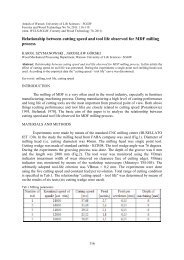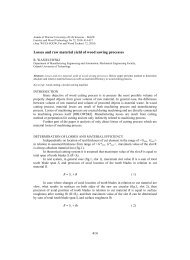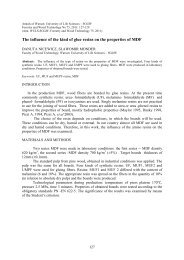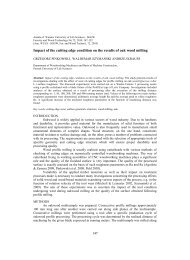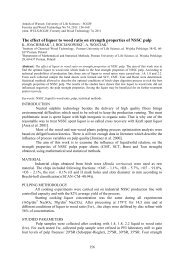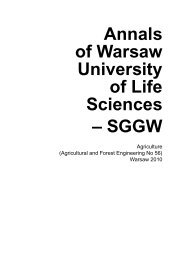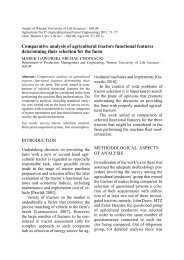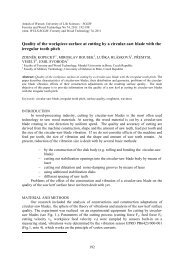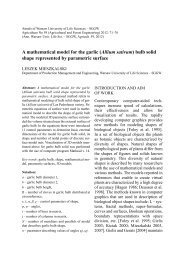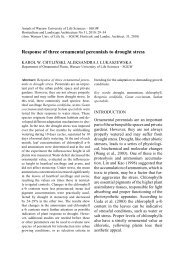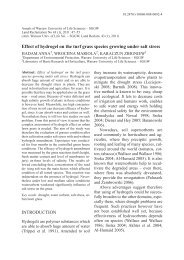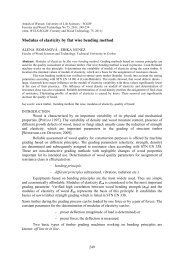Annals of Warsaw University of Life Sciences - SGGW
Annals of Warsaw University of Life Sciences - SGGW
Annals of Warsaw University of Life Sciences - SGGW
Create successful ePaper yourself
Turn your PDF publications into a flip-book with our unique Google optimized e-Paper software.
chain is not hydrolytically degraded. Hydrolysis is well known for unstable dimethylen-ether<br />
bonds and results in formaldehyde emissions from cured resin. MAMINSKI et al. (2006)<br />
studied a possibility to improve adhesive properties and properties <strong>of</strong> hardener using<br />
glutaraldehyde. They stated hypothesis, that glutaraldehyde added will form 5-carbon crosslinks<br />
in the adhesive network; this way also water resistance <strong>of</strong> adhesive can be improved.<br />
When summing all the experiments, we can say that simultaneous presence <strong>of</strong> both<br />
components (activator AG based on glutaraldehyde, and collagen hydrolysate HC) gives the<br />
best environment for curing and good results from the point <strong>of</strong> view <strong>of</strong> content and emissions<br />
<strong>of</strong> formaldehyde (fig. 2).<br />
100<br />
100<br />
fd<br />
content -<br />
relative<br />
value (%)<br />
80<br />
60<br />
40<br />
20<br />
fd<br />
emissionrelative<br />
value (%)<br />
80<br />
60<br />
40<br />
20<br />
0<br />
HrR Hr1 Hr3<br />
0<br />
HrR Hr1 Hr3<br />
UF adhesive mixture<br />
UF adhesive mixture<br />
adhesive without HC<br />
adhesive with 5 % HC<br />
adhesive without HC<br />
adhesive with 8 % HC<br />
Fig. 2 Content <strong>of</strong> formaldehyde in plywood and emissions <strong>of</strong> formaldehyde when various<br />
UF adhesive mixtures were used<br />
CONCLUSION<br />
In conclusion we can say that:<br />
• the best results <strong>of</strong> formaldehyde content in plywood were achieved by UF adhesive<br />
mixture containing Hr3 and 5 % HC,<br />
• the lowest emission from glued material was measured at UF adhesive mixture with<br />
Hr3 and 8 % HC.<br />
Simultaneous presence <strong>of</strong> both components in the UF adhesive mixture both reduced the<br />
amount <strong>of</strong> formaldehyde in plywood, and reduced the formaldehyde emission from cured UF<br />
adhesive film. As for the UF adhesives are widely used, utilization <strong>of</strong> secondary raw materials<br />
(skin collagen hydrolysates) in adhesive production can positively influence the environment<br />
and be economically interesting.<br />
Acknowledgments<br />
This paper was worked out in the frame <strong>of</strong> the project VEGA 1/0517/09 and projects APVV-<br />
0521-07 and APVV-0773-07.<br />
REFERENCES<br />
1. LANGMAIER, F. et al. 2004. Curing <strong>of</strong> urea-formaldehyde adhesives with collagen type<br />
hydrolysates under acid condition. In Journal <strong>of</strong> Thermal Analysis and Calorimetry. 2004,<br />
76, p. 1015-1023.<br />
2. LANGMAIER, F. et al. 2005. Curing urea-formaldehyde adhesives with hydrolysates <strong>of</strong><br />
chrome-tanned leather waste from leather production. In International Journal <strong>of</strong><br />
Adhesion and Adhesives. 2005, 25, p. 101-108.<br />
3. MAMINSKI, M.L., PAWLICKI, J., PARZUCHOWSKI, P. 2006. Improved water<br />
resistance and adhesive performance <strong>of</strong> a commercial UF resin blended with<br />
glutaraldehyde. In The Journal <strong>of</strong> Adhesion. ISSN 0021-8464, 2006, 82, p.629-641.<br />
47



